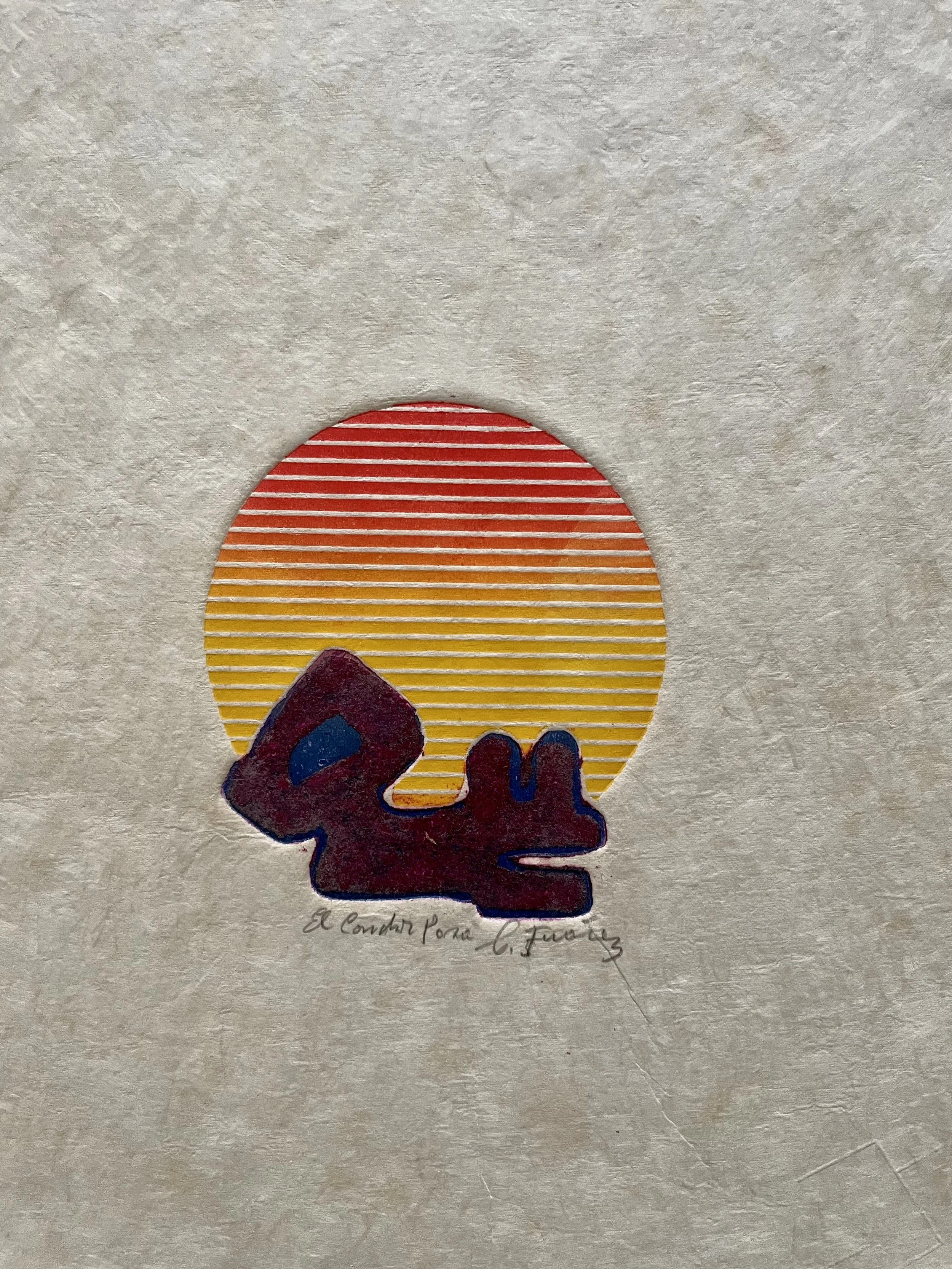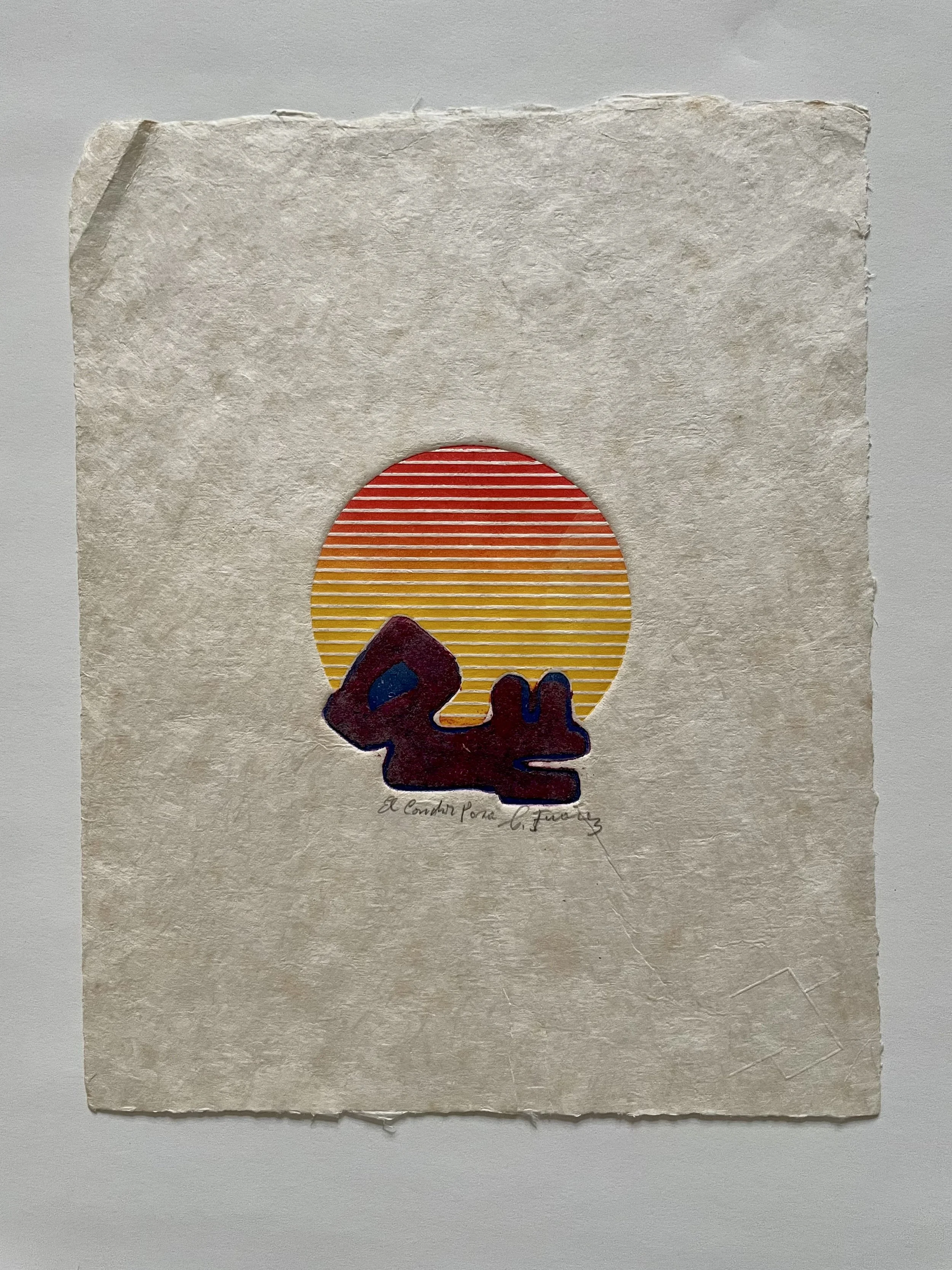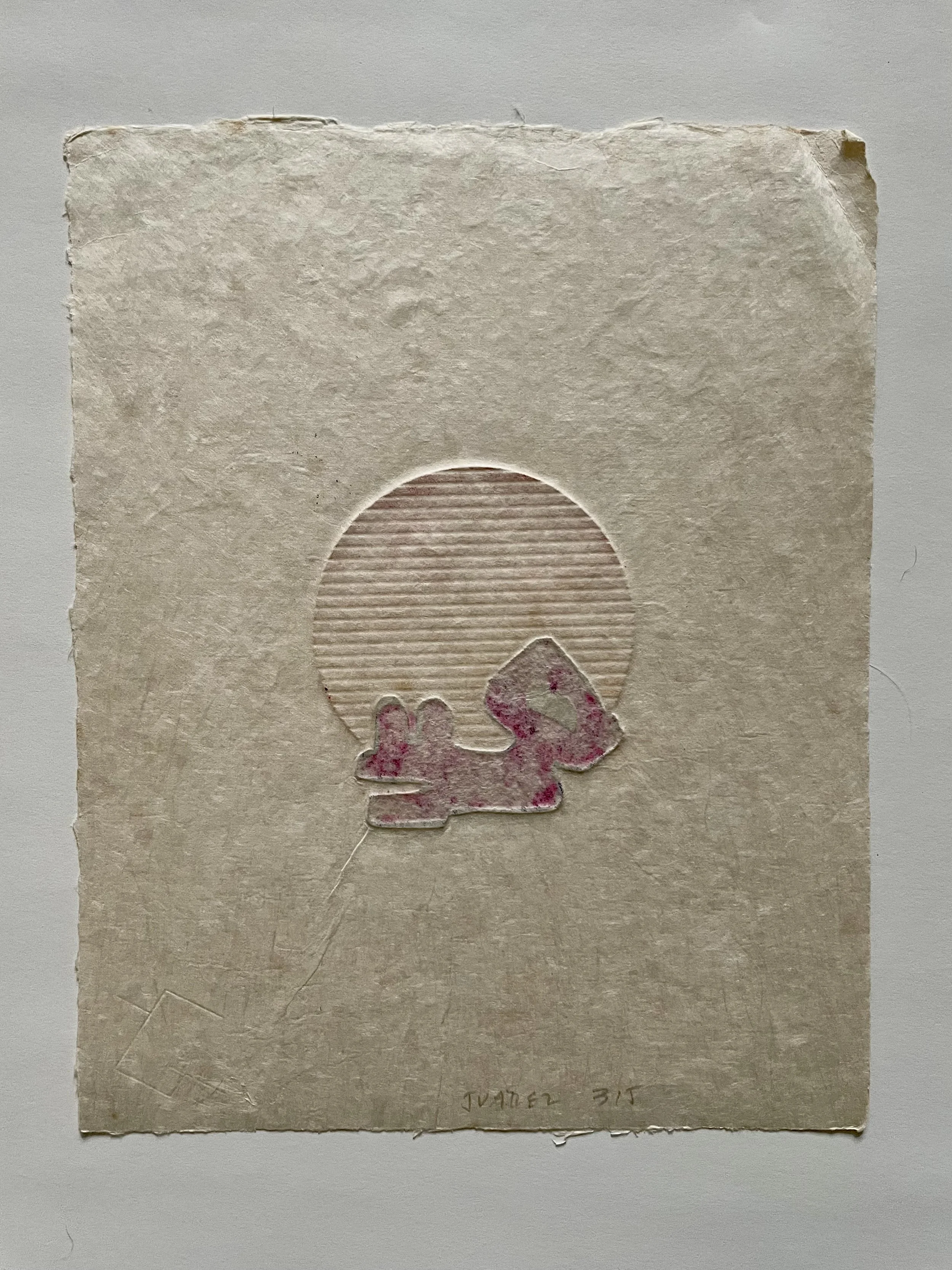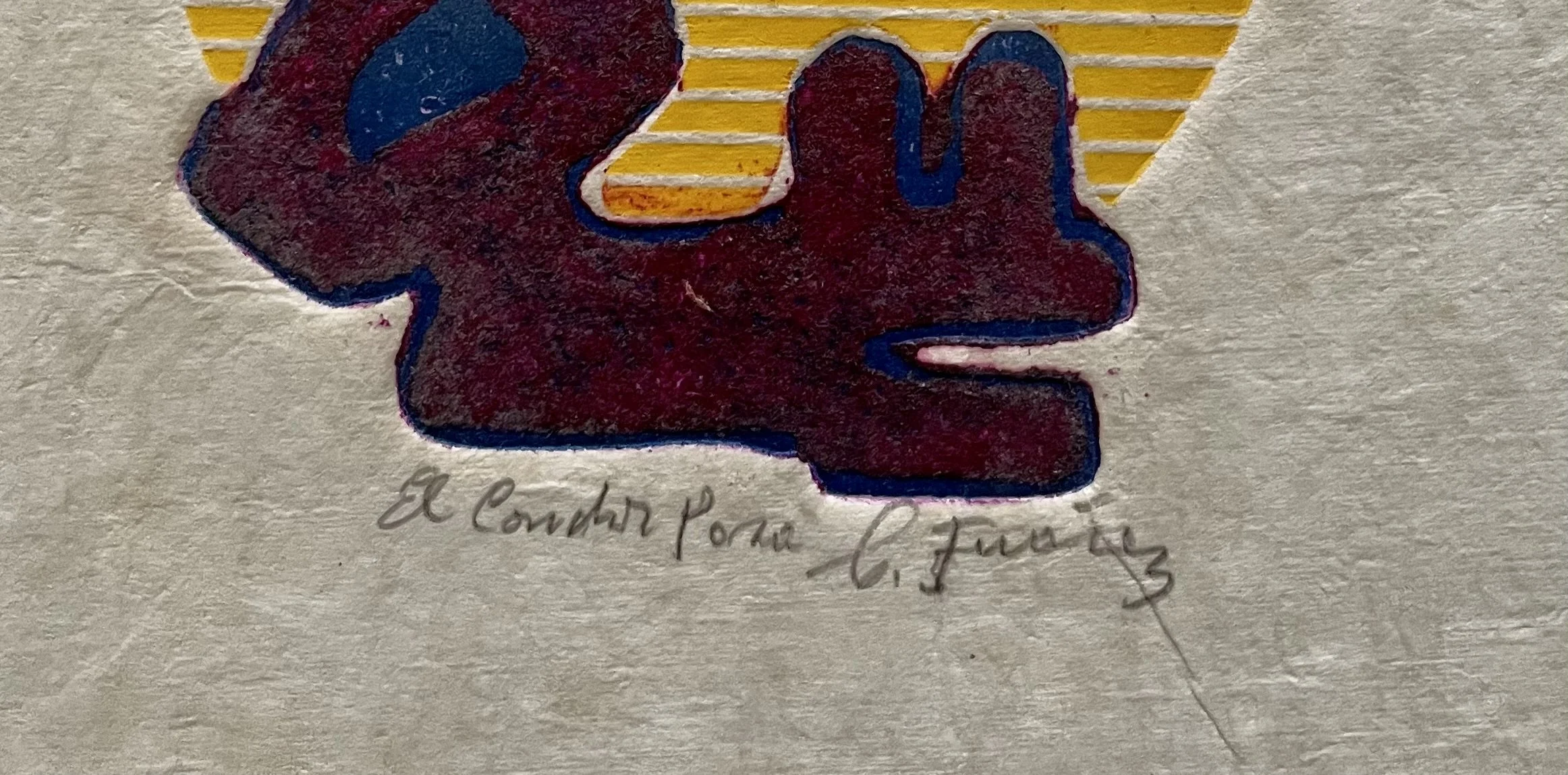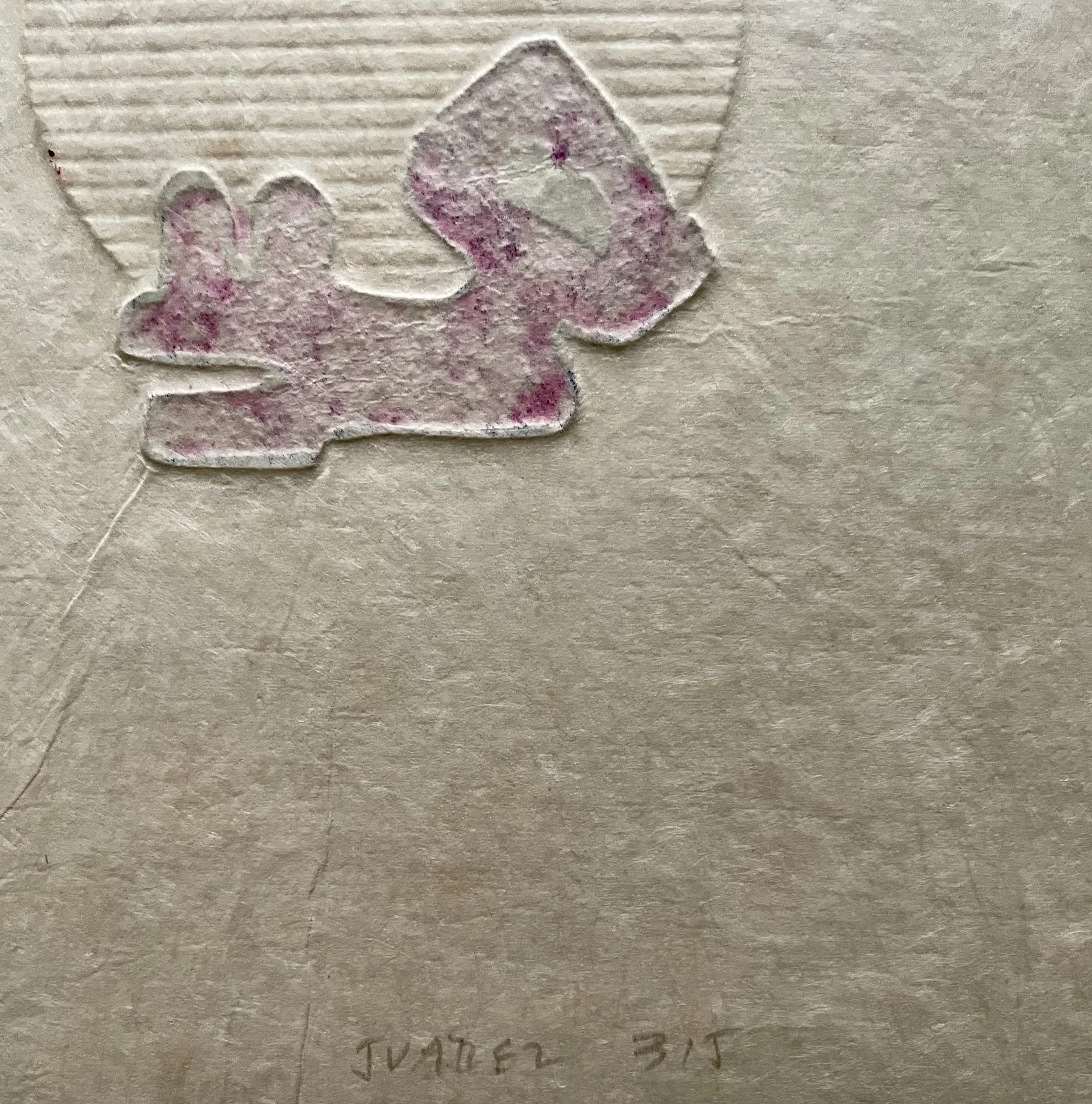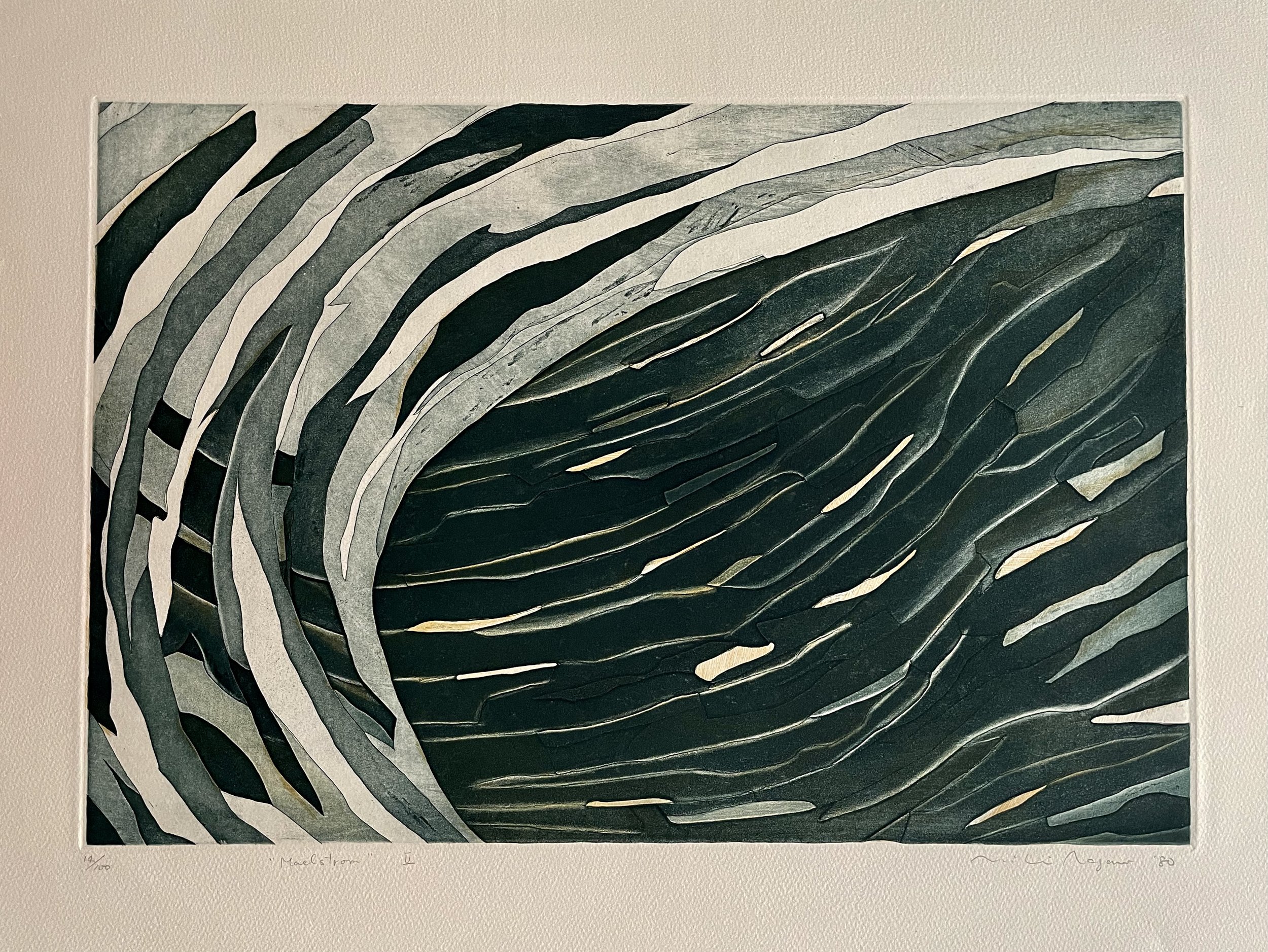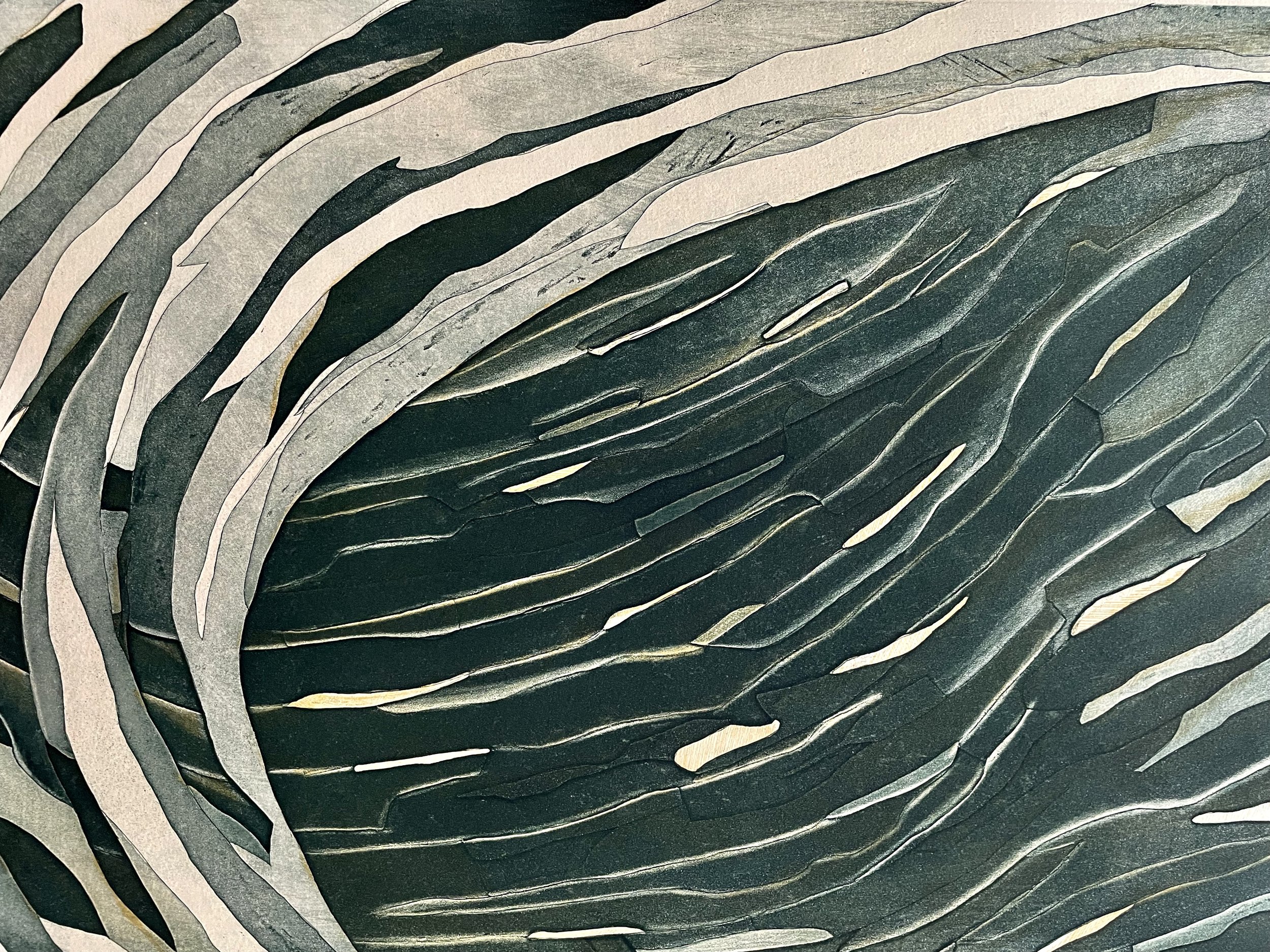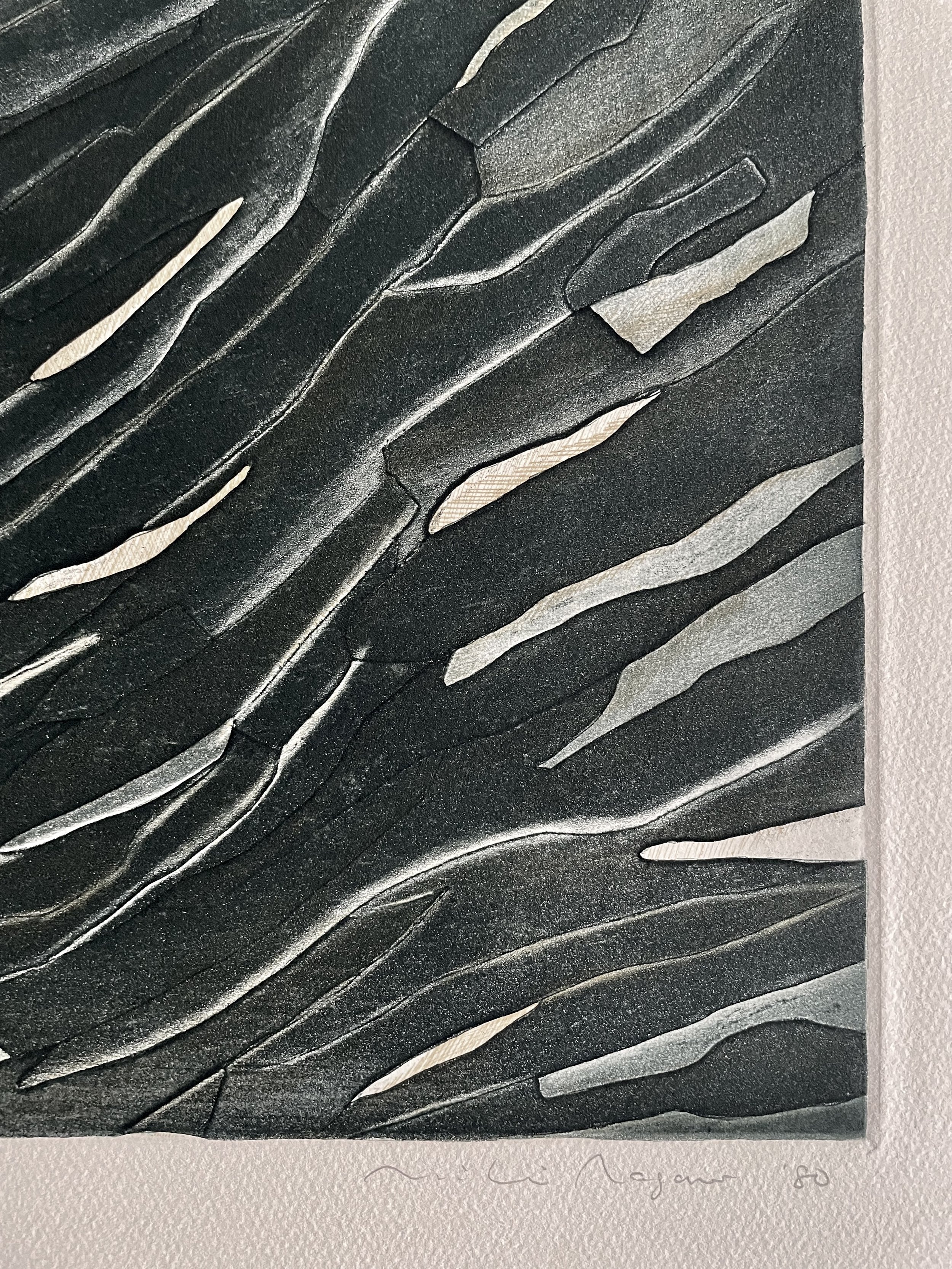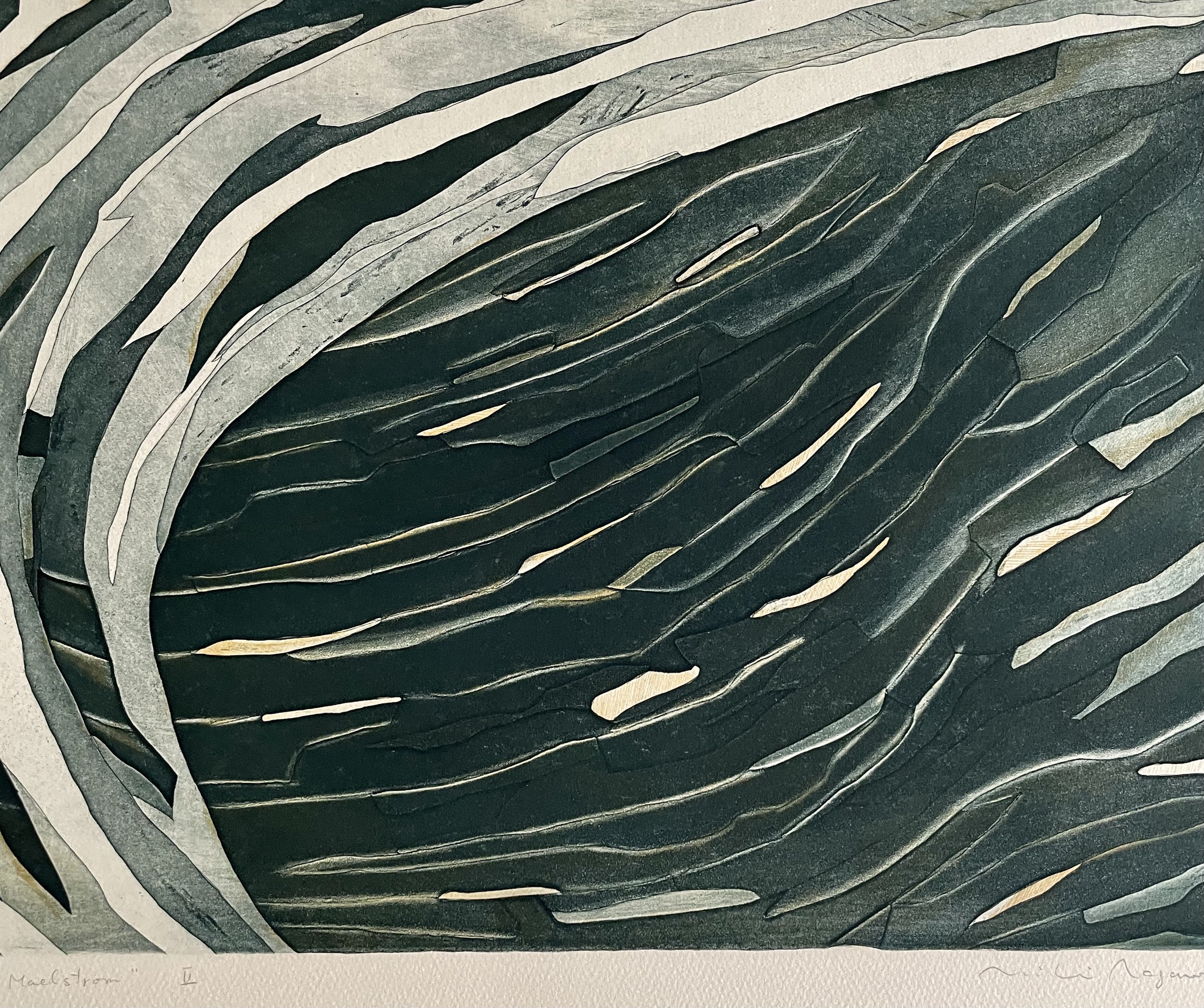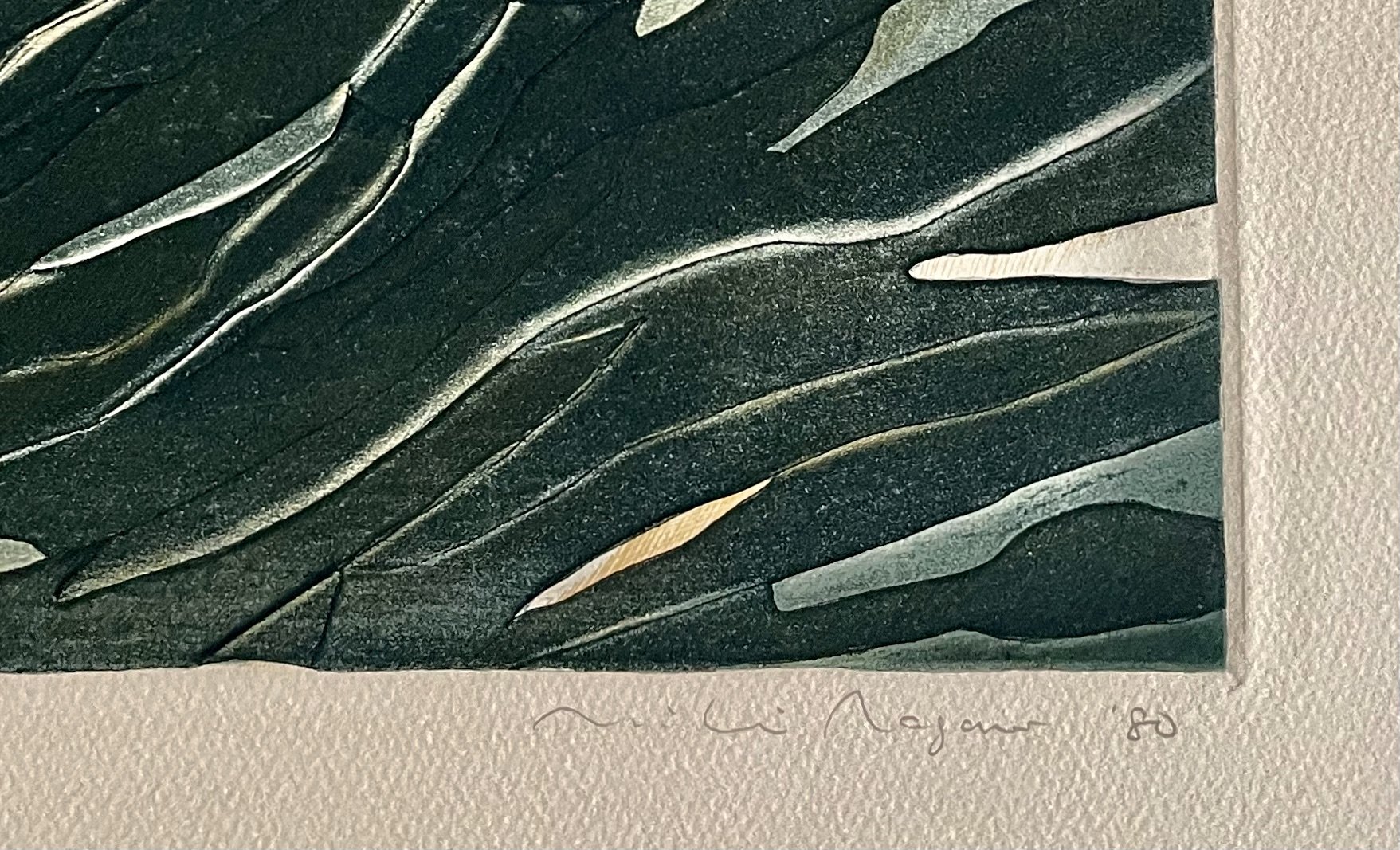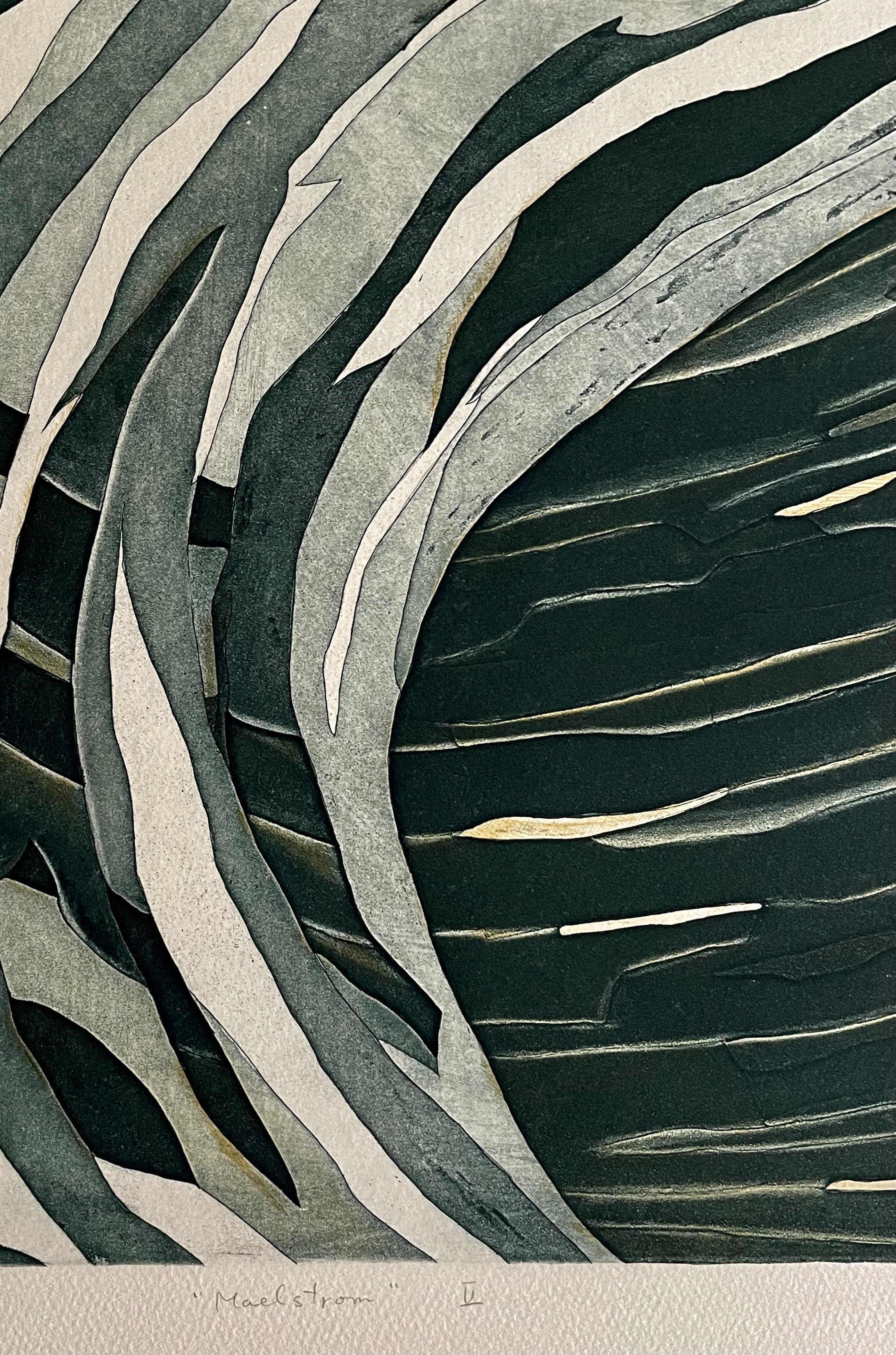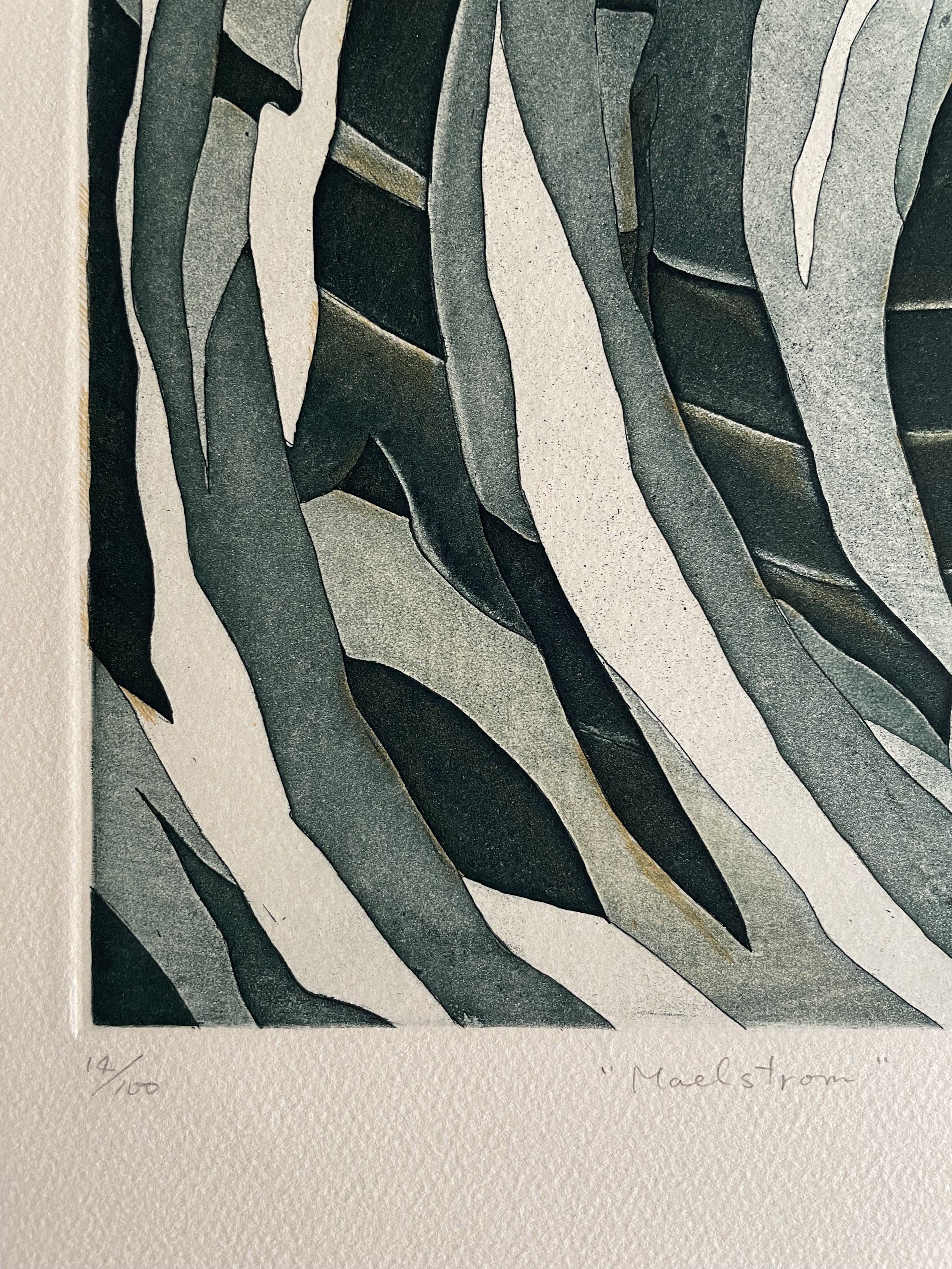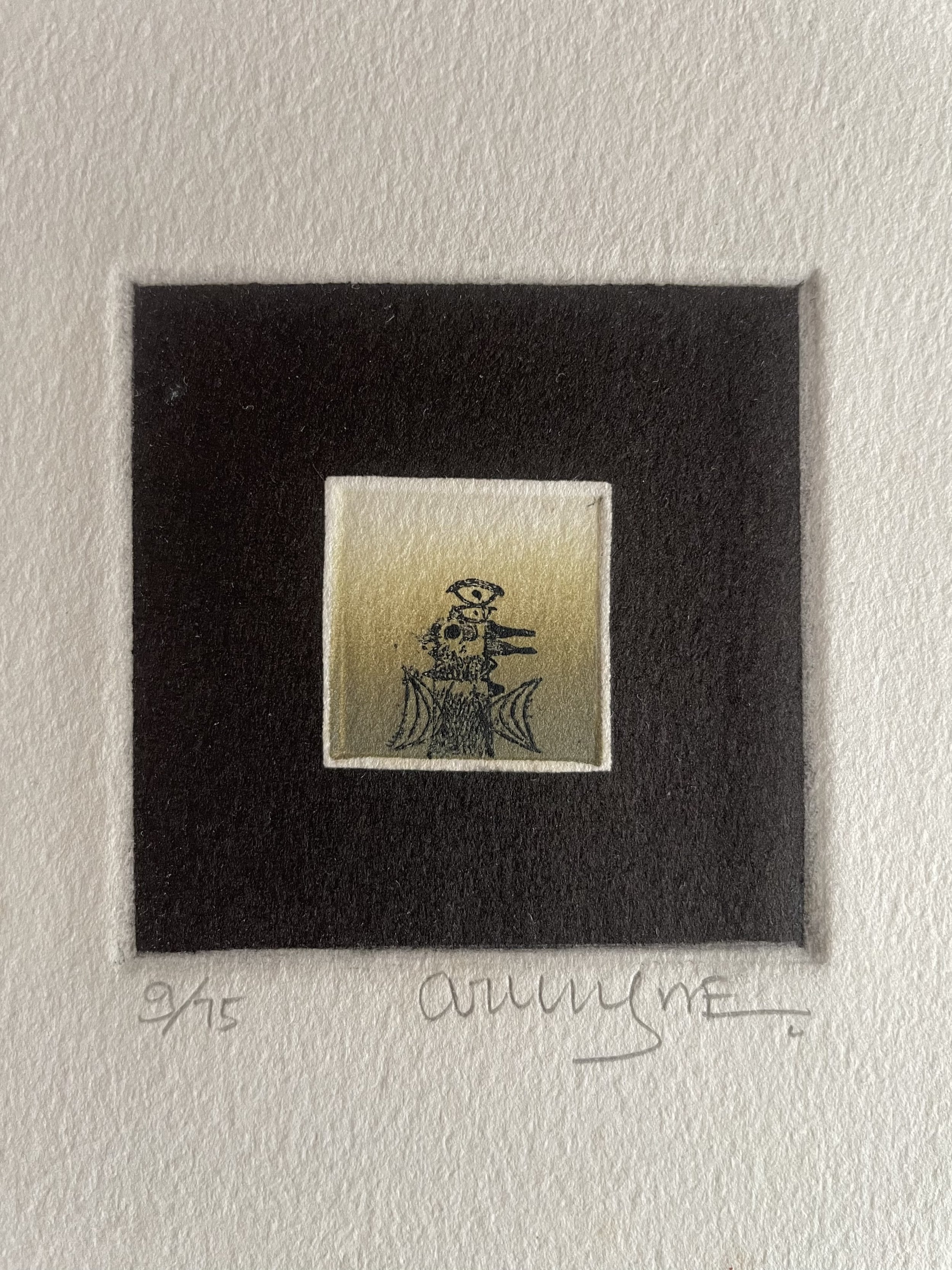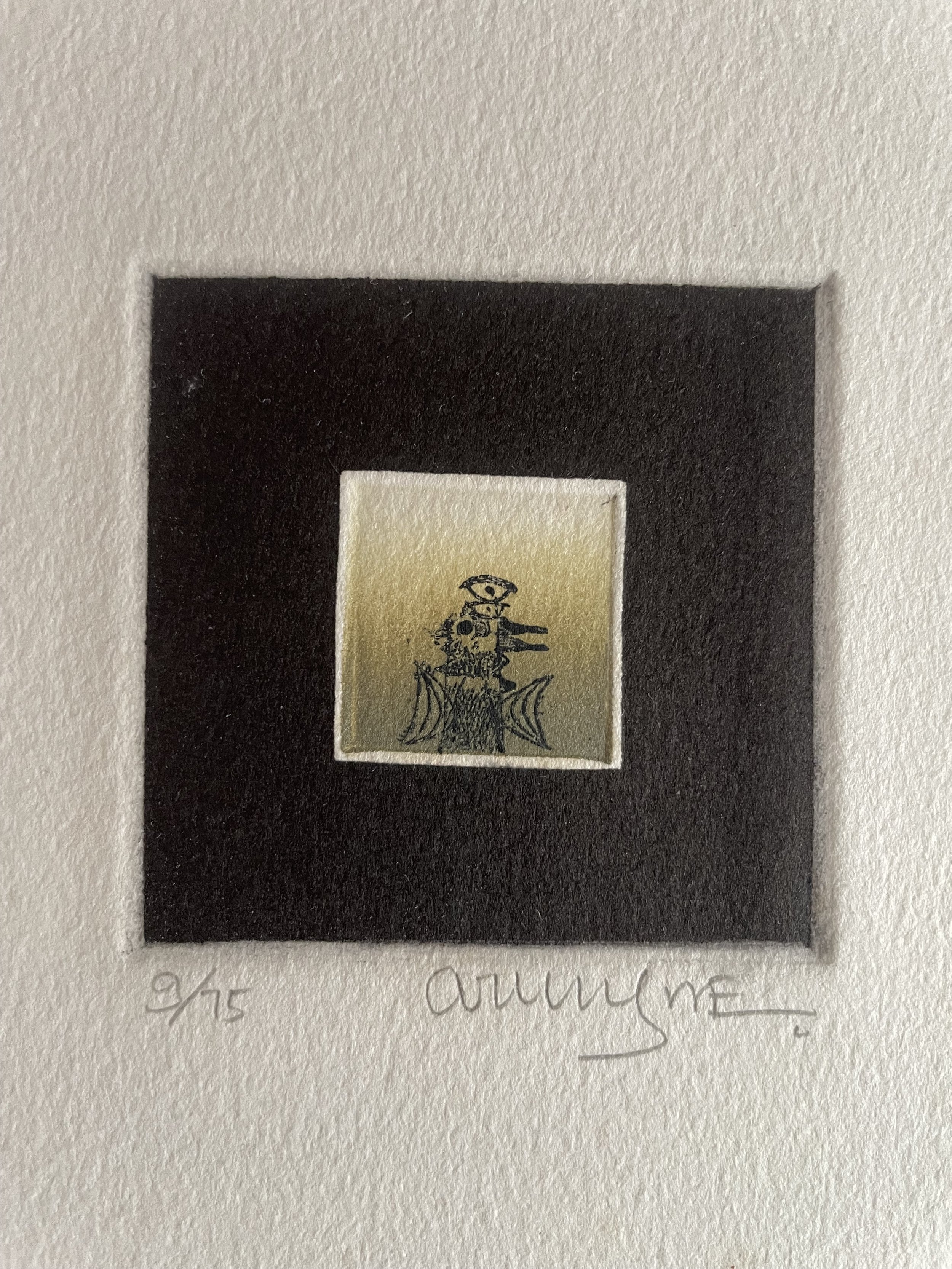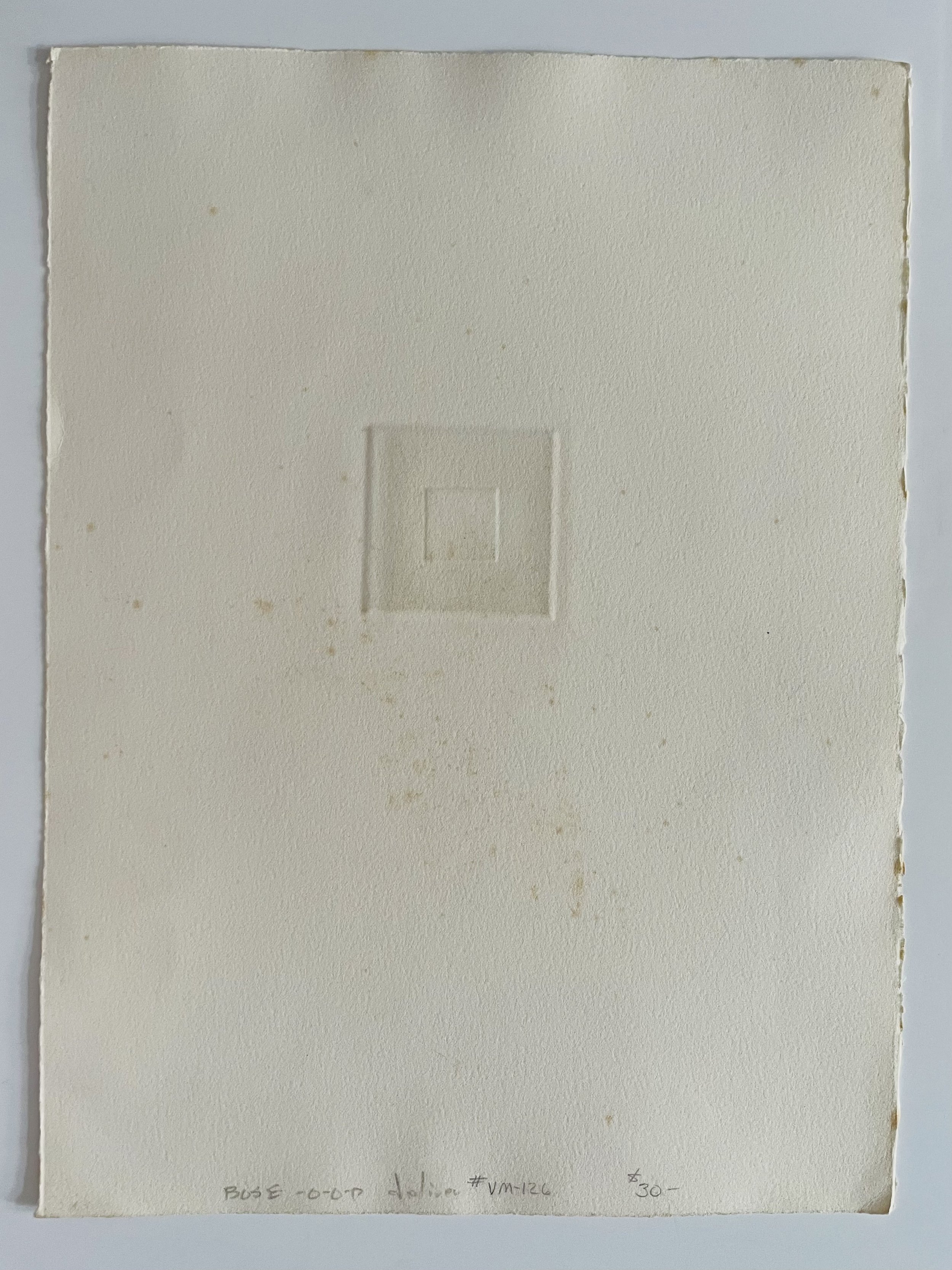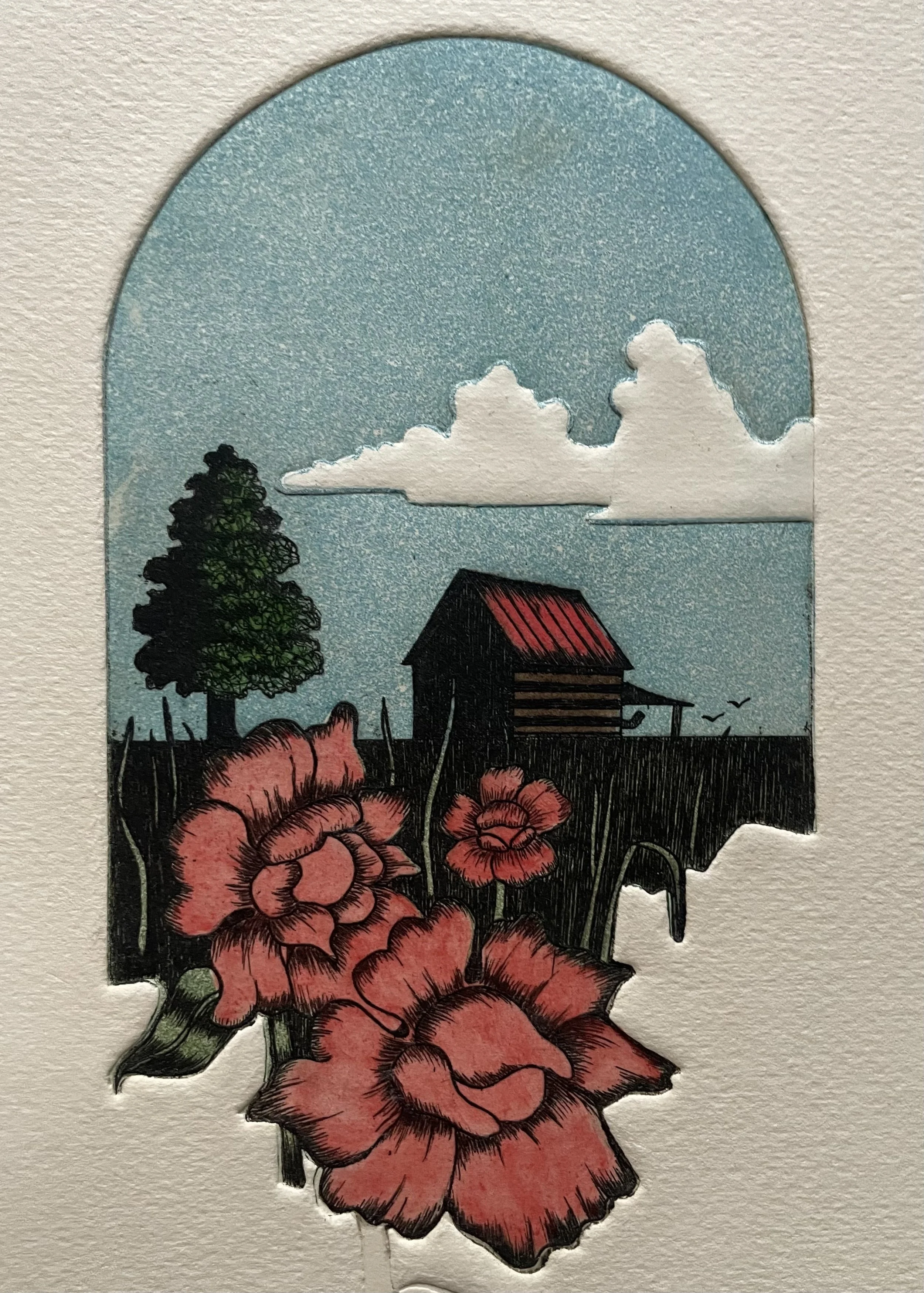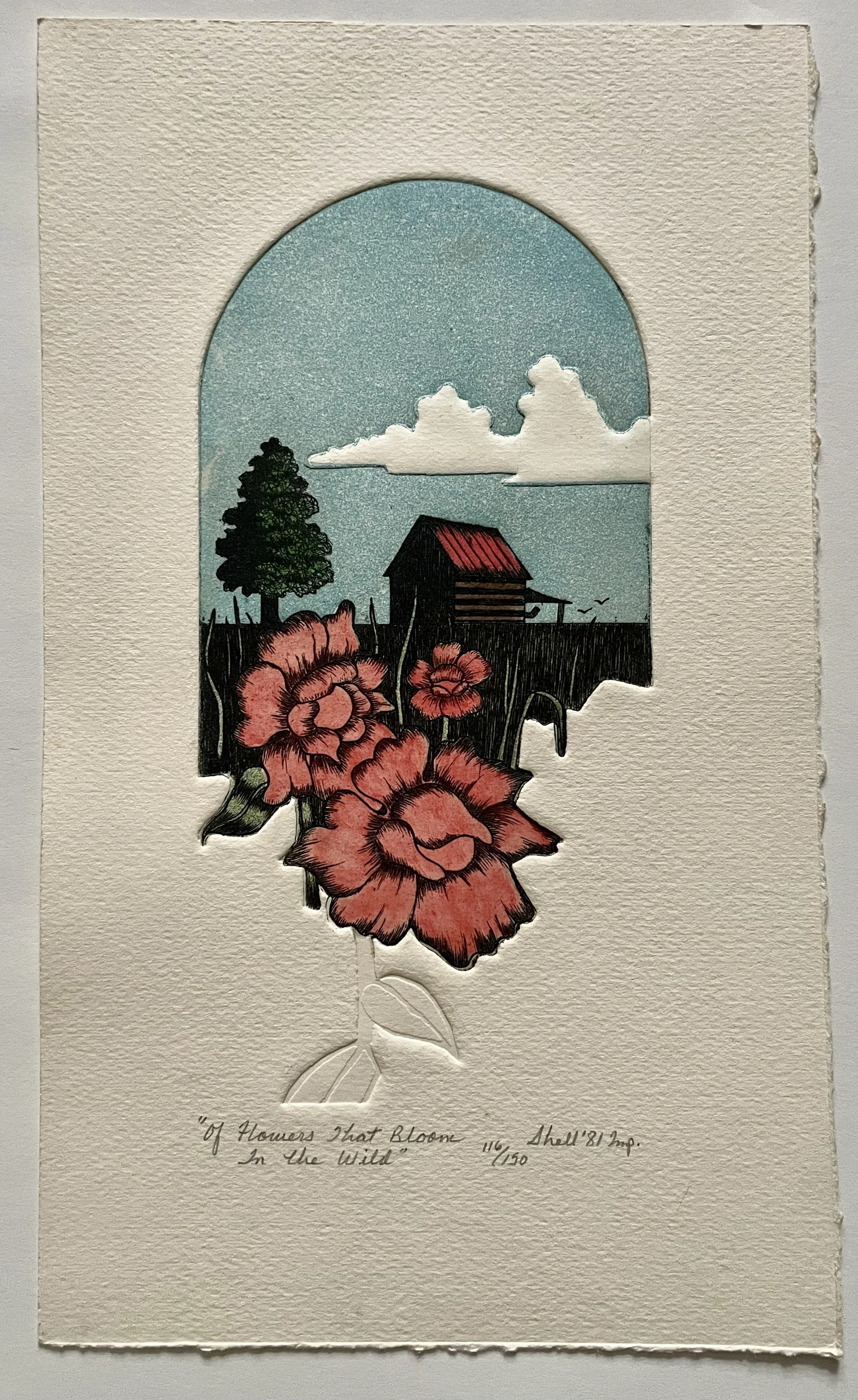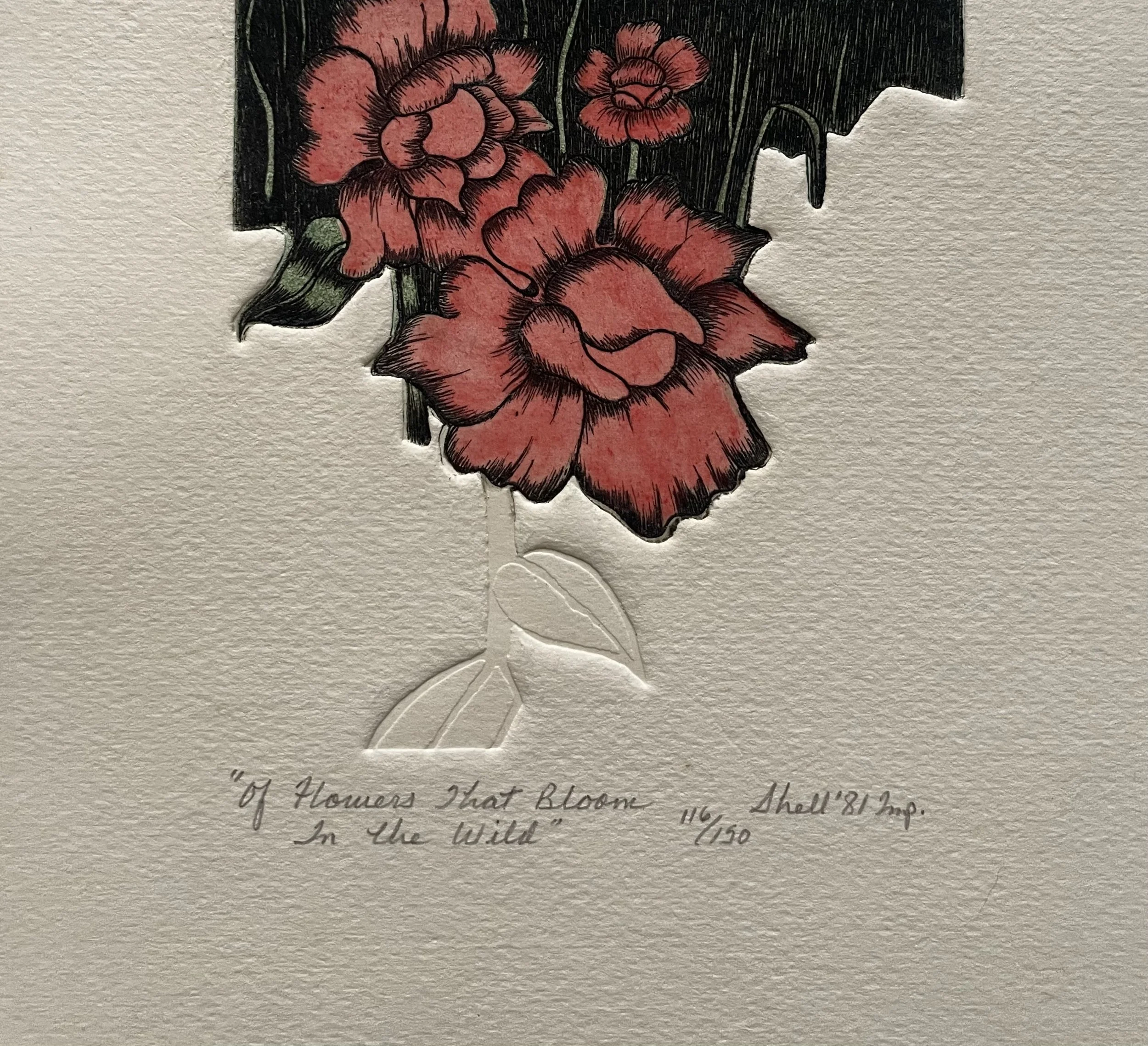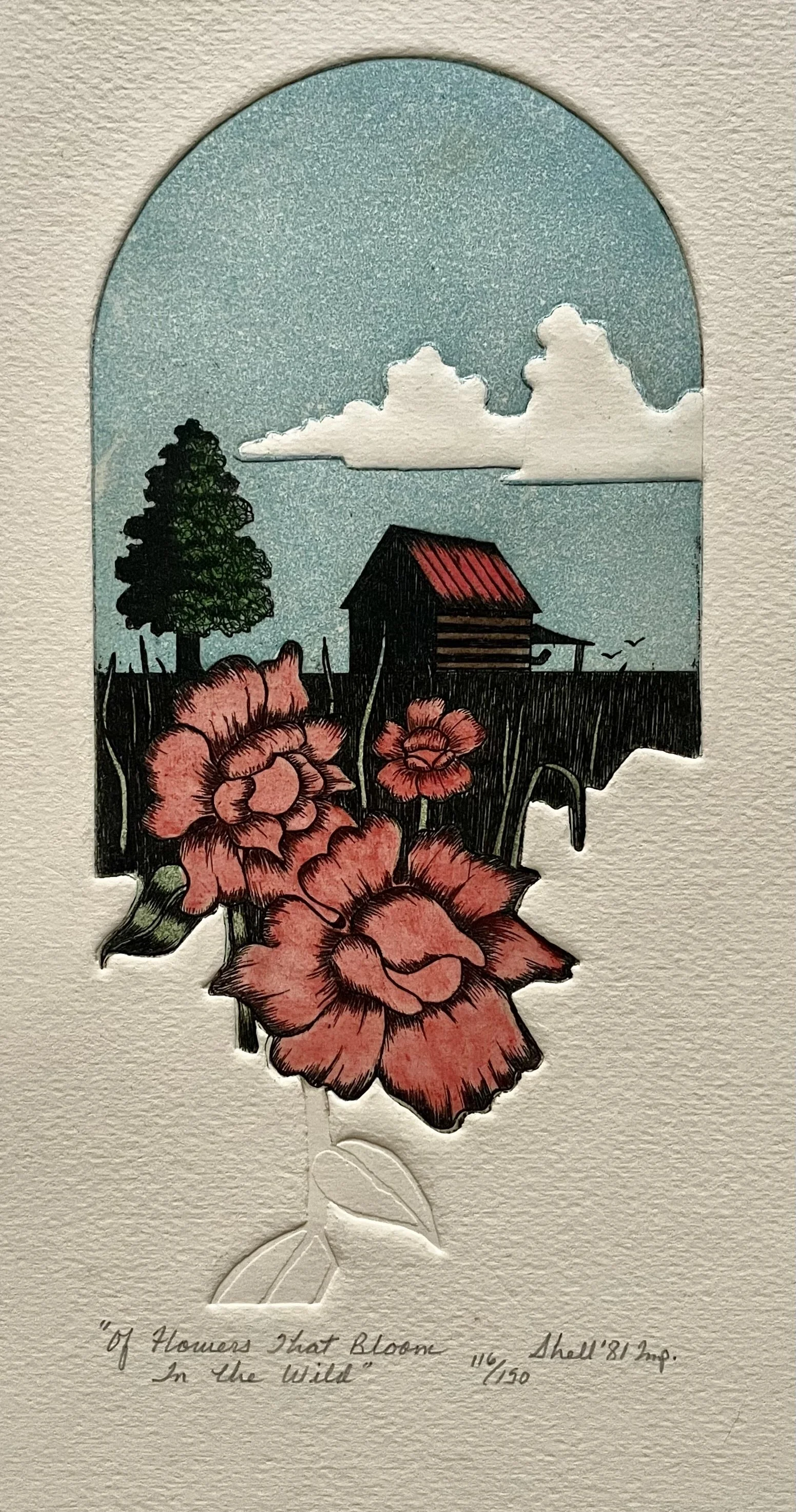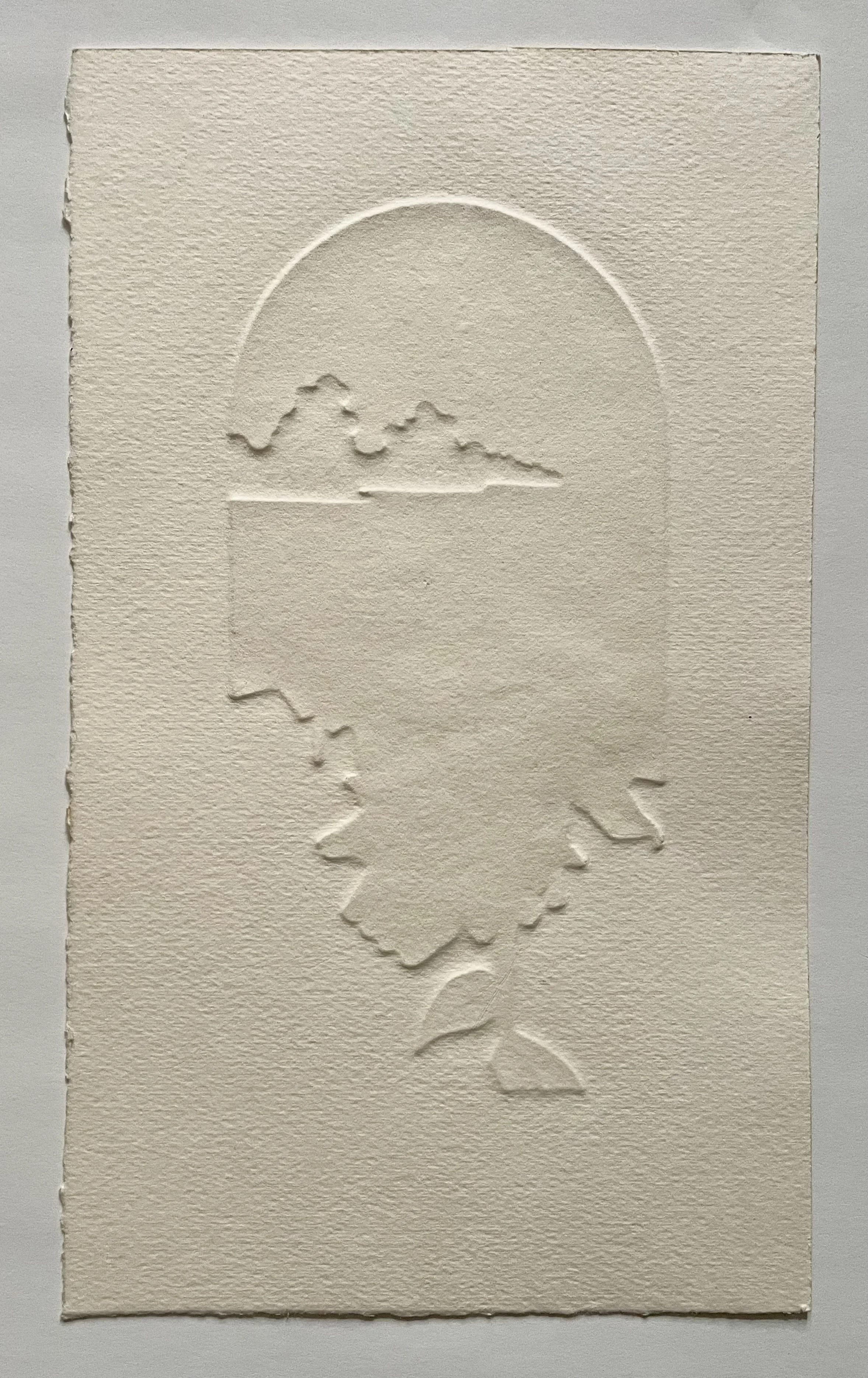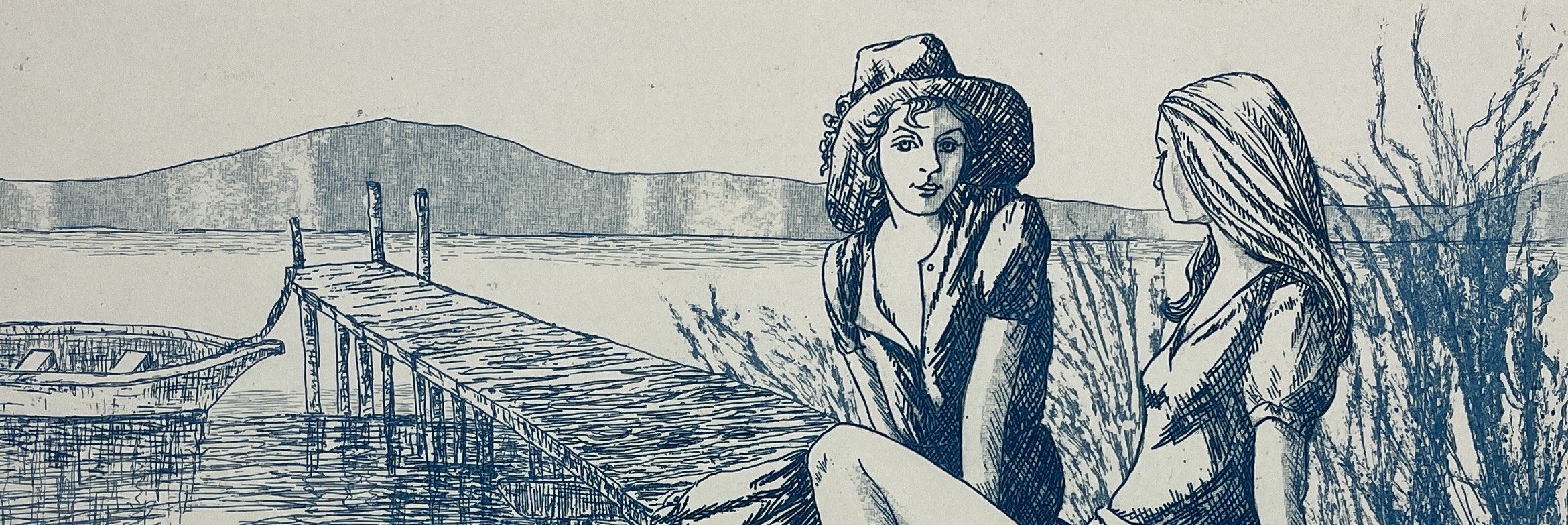El Cóndor Pasa, Claudio Juárez (1938–2001), 1970s abstract etching & aquatint, 10×8 in, signed & numbered on handmade paper.
This rare 1970s abstract etching with aquatint by Peruvian master printmaker Claudio Juárez captures the Andean spirit of El Cóndor Pasa through bold color, handmade paper, and Juárez’s signature fusion of modernist abstraction with Latin American symbolism. Signed and numbered, this finely executed work reflects Juárez’s internationally acclaimed printmaking practice developed across Lima, Paris, Rio de Janeiro, and New York.
Artwork Description
El Cóndor Pasa exemplifies Claudio Juárez’s mastery of experimental etching and aquatint, executed on textured handmade paper characteristic of his 1970s production. A radiant sun—constructed through fine horizontal gradations from red to golden yellow—serves as the atmospheric backdrop for an abstracted condor-like form rendered in deep burgundy, ultramarine, and subtle tonal layering. The piece is hand-signed “C. Juarez” and titled El Cóndor Pasa beneath the image, with Juárez’s distinctive cursive script.
The composition merges Latin American cultural identity, Andean mythology, and European-trained abstraction. The condor—the sacred messenger of the highlands—appears distilled into a modernist, biomorphic silhouette, hovering before the sun. Juárez’s use of aquatint creates smooth chromatic transitions while his etching lines hold the graphic clarity emblematic of the Atelier 17 influence he absorbed in Paris under Stanley William Hayter.
The handmade paper introduces natural fibers and deckled edges that enhance the tactile quality of the print. The work reflects Juárez’s long-standing interest in symbolic forms, rhythmic color fields, and cross-cultural visual vocabulary, translating Peruvian heritage through a global modernist lens.
Biography of Claudio Juárez
Claudio Juárez (1938–2001) was an internationally celebrated Peruvian-born painter and master printmaker whose career unfolded across Latin America, Europe, and the United States. Born in Ayacucho, Peru, a region deeply associated with Andean culture, Juárez carried the visual memories of its landscapes and mythologies throughout his artistic life.
He studied painting and printmaking at the Escuela Nacional de Bellas Artes de Lima, where he was recognized early for his technical promise. In 1960, Juárez received a prestigious fellowship to the Museu de Arte Moderna in Rio de Janeiro, exposing him to Brazil’s modernist movement. This led to a second major award—a Gulbenkian Foundation scholarship—which took him to Paris, placing him in the orbit of the legendary Stanley William Hayter at Atelier 17, the printmaking studio central to the development of modern etching in the 20th century. Under Hayter, Juárez refined his use of viscosity color, aquatint modulation, and experimental surfaces.
Between the 1960s and late 1970s, Juárez worked, taught, and exhibited throughout Spain, Portugal, Norway, and Denmark, absorbing European modernism while maintaining strong ties to Latin American visual vocabulary. His arrival in New York in 1969 marked the beginning of a prolific period: over the next four decades he produced more than 7,000 original prints, becoming one of the most productive printmakers of his generation.
Juárez’s work is distinguished by:
finely graded color transitions
textured surfaces and layered aquatints
interplay between abstract form and symbolic cultural motifs
the use of handmade or fibrous papers
a syncretic blend of Peruvian ancestral imagery with contemporary graphic language
His exhibition record spans Lima, Rio de Janeiro, Caracas, Havana, Santiago, São Paulo, Madrid, Florence, Venice, New York, Miami, Chicago, Washington DC, Montreal, Ottawa, Geneva, Oslo, Copenhagen, among many others.
Public collections holding his work include:
Victoria & Albert Museum (London)
Bibliothèque nationale de France
Montreal Museum of Fine Arts
New York Public Library
El Museo del Barrio (NYC)
major Latin American museums and university collections
Juárez is recognized today as a pivotal figure connecting Andean cultural symbology, international modernism, and the experimental print revival of the mid-20th century.
Claudio Juárez, El Cóndor Pasa, 1970s. Abstract etching with aquatint on handmade paper, 10×8 in. Signed, titled, and numbered. Excellent impression with rich color and texture.
CERTIFICATE OF VALUE & AUTHENTICATION
Artist: Claudio Juárez (1938–2001)
Title:El Cóndor Pasa
Date: 1970s
Medium: Abstract Etching with Aquatint on Handmade Paper
Dimensions: 10 × 8 inches
Edition: Signed & Numbered by Artist
Signature: Hand-signed “C. Juarez,” titled in graphite
Condition: Excellent; strong color, intact handmade sheet, no foxing
Authenticity: Verified through signature comparison, plate characteristics, paper type, period style, and Juárez’s known technical methods from the 1970s.
Current Owner: Artfind Gallery, Washington, DC
This print is confirmed to be an original work by Claudio Juárez.
Provenance Chain
Artist’s Studio, New York – 1970s
Private Collection, NYC
Artfind Gallery, Washington, DC – current owner
Claudio Juárez’s El Cóndor Pasa distills motion, music, and myth into a strikingly simple yet resonant composition. Against the textured, natural surface of handmade paper, a deep maroon abstract form—suggestive of a condor in repose or flight—rests before a radiant, striped sun that transitions from crimson to gold. The horizontal bands evoke both the rhythmic flow of Andean landscapes and the melodic lines of the famous Peruvian folk song from which the work takes its title.
El Cóndor Pasa, Claudio Juárez (1938–2001), 1970s abstract etching & aquatint, 10×8 in, signed & numbered on handmade paper.
This rare 1970s abstract etching with aquatint by Peruvian master printmaker Claudio Juárez captures the Andean spirit of El Cóndor Pasa through bold color, handmade paper, and Juárez’s signature fusion of modernist abstraction with Latin American symbolism. Signed and numbered, this finely executed work reflects Juárez’s internationally acclaimed printmaking practice developed across Lima, Paris, Rio de Janeiro, and New York.
Artwork Description
El Cóndor Pasa exemplifies Claudio Juárez’s mastery of experimental etching and aquatint, executed on textured handmade paper characteristic of his 1970s production. A radiant sun—constructed through fine horizontal gradations from red to golden yellow—serves as the atmospheric backdrop for an abstracted condor-like form rendered in deep burgundy, ultramarine, and subtle tonal layering. The piece is hand-signed “C. Juarez” and titled El Cóndor Pasa beneath the image, with Juárez’s distinctive cursive script.
The composition merges Latin American cultural identity, Andean mythology, and European-trained abstraction. The condor—the sacred messenger of the highlands—appears distilled into a modernist, biomorphic silhouette, hovering before the sun. Juárez’s use of aquatint creates smooth chromatic transitions while his etching lines hold the graphic clarity emblematic of the Atelier 17 influence he absorbed in Paris under Stanley William Hayter.
The handmade paper introduces natural fibers and deckled edges that enhance the tactile quality of the print. The work reflects Juárez’s long-standing interest in symbolic forms, rhythmic color fields, and cross-cultural visual vocabulary, translating Peruvian heritage through a global modernist lens.
Biography of Claudio Juárez
Claudio Juárez (1938–2001) was an internationally celebrated Peruvian-born painter and master printmaker whose career unfolded across Latin America, Europe, and the United States. Born in Ayacucho, Peru, a region deeply associated with Andean culture, Juárez carried the visual memories of its landscapes and mythologies throughout his artistic life.
He studied painting and printmaking at the Escuela Nacional de Bellas Artes de Lima, where he was recognized early for his technical promise. In 1960, Juárez received a prestigious fellowship to the Museu de Arte Moderna in Rio de Janeiro, exposing him to Brazil’s modernist movement. This led to a second major award—a Gulbenkian Foundation scholarship—which took him to Paris, placing him in the orbit of the legendary Stanley William Hayter at Atelier 17, the printmaking studio central to the development of modern etching in the 20th century. Under Hayter, Juárez refined his use of viscosity color, aquatint modulation, and experimental surfaces.
Between the 1960s and late 1970s, Juárez worked, taught, and exhibited throughout Spain, Portugal, Norway, and Denmark, absorbing European modernism while maintaining strong ties to Latin American visual vocabulary. His arrival in New York in 1969 marked the beginning of a prolific period: over the next four decades he produced more than 7,000 original prints, becoming one of the most productive printmakers of his generation.
Juárez’s work is distinguished by:
finely graded color transitions
textured surfaces and layered aquatints
interplay between abstract form and symbolic cultural motifs
the use of handmade or fibrous papers
a syncretic blend of Peruvian ancestral imagery with contemporary graphic language
His exhibition record spans Lima, Rio de Janeiro, Caracas, Havana, Santiago, São Paulo, Madrid, Florence, Venice, New York, Miami, Chicago, Washington DC, Montreal, Ottawa, Geneva, Oslo, Copenhagen, among many others.
Public collections holding his work include:
Victoria & Albert Museum (London)
Bibliothèque nationale de France
Montreal Museum of Fine Arts
New York Public Library
El Museo del Barrio (NYC)
major Latin American museums and university collections
Juárez is recognized today as a pivotal figure connecting Andean cultural symbology, international modernism, and the experimental print revival of the mid-20th century.
Claudio Juárez, El Cóndor Pasa, 1970s. Abstract etching with aquatint on handmade paper, 10×8 in. Signed, titled, and numbered. Excellent impression with rich color and texture.
CERTIFICATE OF VALUE & AUTHENTICATION
Artist: Claudio Juárez (1938–2001)
Title:El Cóndor Pasa
Date: 1970s
Medium: Abstract Etching with Aquatint on Handmade Paper
Dimensions: 10 × 8 inches
Edition: Signed & Numbered by Artist
Signature: Hand-signed “C. Juarez,” titled in graphite
Condition: Excellent; strong color, intact handmade sheet, no foxing
Authenticity: Verified through signature comparison, plate characteristics, paper type, period style, and Juárez’s known technical methods from the 1970s.
Current Owner: Artfind Gallery, Washington, DC
This print is confirmed to be an original work by Claudio Juárez.
Provenance Chain
Artist’s Studio, New York – 1970s
Private Collection, NYC
Artfind Gallery, Washington, DC – current owner
Claudio Juárez’s El Cóndor Pasa distills motion, music, and myth into a strikingly simple yet resonant composition. Against the textured, natural surface of handmade paper, a deep maroon abstract form—suggestive of a condor in repose or flight—rests before a radiant, striped sun that transitions from crimson to gold. The horizontal bands evoke both the rhythmic flow of Andean landscapes and the melodic lines of the famous Peruvian folk song from which the work takes its title.
